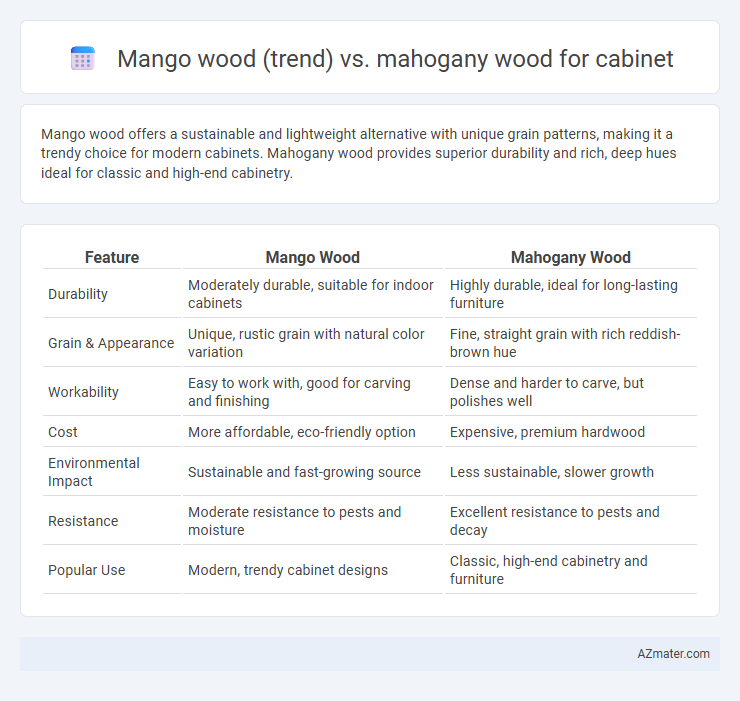Mango wood offers a sustainable and lightweight alternative with unique grain patterns, making it a trendy choice for modern cabinets. Mahogany wood provides superior durability and rich, deep hues ideal for classic and high-end cabinetry.
Table of Comparison
| Feature | Mango Wood | Mahogany Wood |
|---|---|---|
| Durability | Moderately durable, suitable for indoor cabinets | Highly durable, ideal for long-lasting furniture |
| Grain & Appearance | Unique, rustic grain with natural color variation | Fine, straight grain with rich reddish-brown hue |
| Workability | Easy to work with, good for carving and finishing | Dense and harder to carve, but polishes well |
| Cost | More affordable, eco-friendly option | Expensive, premium hardwood |
| Environmental Impact | Sustainable and fast-growing source | Less sustainable, slower growth |
| Resistance | Moderate resistance to pests and moisture | Excellent resistance to pests and decay |
| Popular Use | Modern, trendy cabinet designs | Classic, high-end cabinetry and furniture |
Introduction to Mango and Mahogany Wood for Cabinets
Mango wood, known for its sustainability and unique grain patterns, offers a trendy and eco-friendly alternative for cabinet construction compared to traditional mahogany wood, prized for its rich color and durability. Both woods provide excellent strength and aesthetic appeal, but mango wood is gaining popularity due to faster growth cycles and environmental benefits. Mahogany remains a classic choice, valued for its fine texture and long-lasting performance in high-end cabinetry.
Understanding the Mango Wood Trend
Mango wood has gained popularity in cabinet making due to its sustainable sourcing, attractive grain patterns, and cost-effectiveness compared to traditional mahogany wood. The mango wood trend emphasizes eco-friendly practices as mango trees are harvested once their fruit-bearing life ends, making it a rapidly renewable resource. Although mahogany offers superior durability and a rich, deep color ideal for classic cabinetry, mango wood's unique matte finish and diverse color variations appeal to contemporary and rustic interior designs.
Mahogany Wood: Classic Allure in Cabinetry
Mahogany wood offers a classic allure in cabinetry with its rich, deep reddish-brown hues and fine, straight grain that exudes elegance and timeless appeal. Compared to the lighter, more rustic look of mango wood, mahogany is prized for its durability, natural resistance to decay, and smooth finish, making it ideal for high-end cabinets. Its ability to age gracefully and take polish well ensures mahogany cabinets remain a sophisticated centerpiece in any interior design.
Appearance and Grain Patterns: Mango vs Mahogany
Mango wood boasts a unique and vibrant appearance characterized by varied coloration ranging from light yellow to deep brown with occasional streaks of green or black, creating striking and dynamic grain patterns that add rustic charm to cabinets. In contrast, Mahogany wood features a rich, reddish-brown hue with a consistent and smooth grain that enhances elegance and sophistication in cabinetry design. The bold, irregular grain of mango wood offers a more eclectic and natural look, whereas mahogany's fine, straight grain provides a timeless and polished aesthetic.
Durability and Longevity Comparison
Mango wood offers excellent durability and resistance to wear, making it a popular choice for eco-friendly cabinets that last long under regular use. Mahogany wood is renowned for its superior strength and natural resistance to decay, ensuring exceptional longevity and structural integrity in cabinetry. While mango wood provides a sustainable and sturdy option, mahogany's dense grain and hardness generally result in longer-lasting cabinets with less maintenance.
Environmental Impact and Sustainability
Mango wood is a highly sustainable choice for cabinets due to its rapid growth, efficient land use, and repurposing of trees after fruit harvesting, which reduces deforestation pressures. Mahogany wood, while prized for its durability and rich appearance, often comes from slow-growing tropical forests, leading to significant environmental concerns, including habitat loss and overharvesting. Opting for mango wood supports eco-friendly furniture production by minimizing carbon footprint and promoting renewable resources in comparison to mahogany's more intensive ecological impact.
Cost Differences and Value for Money
Mango wood offers an affordable alternative to mahogany with prices typically 30-50% lower, making it a cost-effective choice for budget-conscious cabinet projects. Mahogany's rich color and durability provide long-term value that often justifies its higher initial cost, especially in premium cabinetry. Choosing mango wood balances lower upfront investment with decent durability, while mahogany delivers superior aesthetic appeal and longevity for higher value.
Maintenance and Care Requirements
Mango wood cabinets require less intensive maintenance than mahogany, as they naturally resist moisture and pests due to their dense grain and high oil content. Mahogany wood demands regular polishing and protection from humidity to prevent warping and fading, making upkeep more labor-intensive and costly. Opting for mango wood offers a durable, low-maintenance option ideal for cabinetry in varying climates.
Suitability for Modern and Traditional Interior Styles
Mango wood offers a light, warm grain and sustainable appeal, making it highly suitable for modern interiors that emphasize eco-friendliness and minimalist design. Mahogany wood, known for its rich, deep reddish-brown hue and durability, complements traditional interiors with ornate detailing and classic elegance. Both woods provide versatility, but mango wood suits contemporary settings while mahogany excels in more formal, historic-inspired decor.
Choosing the Right Wood for Your Cabinets
Mango wood offers a sustainable, eco-friendly option with unique grain patterns and natural durability, making it ideal for budget-conscious and environmentally aware homeowners. Mahogany wood, known for its rich color, fine grain, and superior strength, provides a luxurious finish and long-lasting performance for high-end cabinetry. Choosing between Mango and Mahogany wood depends on balancing affordability, aesthetic preferences, and durability requirements to achieve the perfect cabinet style and function.

Infographic: Mango wood (trend) vs Mahogany wood for Cabinet
 azmater.com
azmater.com